Pricing Guides & Dictionary of Makers Marks for Antiques & Collectibles

A few examples of appraisal values for
THE FORGE
Search our price guide for your own treasures
-
 Mezzotint engraving by Richard
Mezzotint engraving by Richard Earlom (English 1743-1822) entitled ''The Forge'' after a painting by Joseph Wright of Derby published by Boydell in 1773 no foxing or toning slight buckle in the paper 19 1/4'' h. x 23'' w.
Mezzotint engraving by Richard
Mezzotint engraving by Richard Earlom (English 1743-1822) entitled ''The Forge'' after a painting by Joseph Wright of Derby published by Boydell in 1773 no foxing or toning slight buckle in the paper 19 1/4'' h. x 23'' w. -
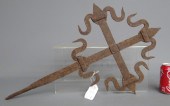 Forged iron Crucifix. 27'' Ht.
Forged iron Crucifix. 27'' Ht.
Forged iron Crucifix. 27'' Ht.
Forged iron Crucifix. 27'' Ht. -
 French Hewing Ax forge welded
French Hewing Ax forge welded with three clear forge lin
French Hewing Ax forge welded
French Hewing Ax forge welded with three clear forge lin -
 METAL WALL HANGING OF A
METAL WALL HANGING OF A BLACKSMITH'S FORGEMetal Wall Hanging of a Blacksmith's Forge,
METAL WALL HANGING OF A
METAL WALL HANGING OF A BLACKSMITH'S FORGEMetal Wall Hanging of a Blacksmith's Forge, -
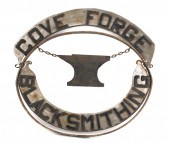 Iron and sheet metal Cove Forge
Iron and sheet metal Cove Forge Blacksmithing trade sign ca. 1930 with a central anvil purportedly from Cape Cod Massachusetts ... ?
Iron and sheet metal Cove Forge
Iron and sheet metal Cove Forge Blacksmithing trade sign ca. 1930 with a central anvil purportedly from Cape Cod Massachusetts ... ? -
 Antique metal statue of a forge
Antique metal statue of a forge worker on a wooden base; overall good condition; H 14 1/2" x D 4 1/2" (approx.)Provenance: Private Collection, Palos Verdes Estates, California
Antique metal statue of a forge
Antique metal statue of a forge worker on a wooden base; overall good condition; H 14 1/2" x D 4 1/2" (approx.)Provenance: Private Collection, Palos Verdes Estates, California -
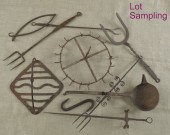 Large group of forged iron
Large group of forged iron 19th/20th c. ?
Large group of forged iron
Large group of forged iron 19th/20th c. ? -
 GROUP WROUGHT IRON FIREPLACE
GROUP WROUGHT IRON FIREPLACE TOOLScomposed group in Arts & Crafts style holder. Comprising poker, tongs, shovel and fork. Largest 45" high, 8" wide. Oxidation, use wear. Property from the Estates of Eve & Peter Mancino, Bridgewater, CT. Condition: Auction buying is wholesale and not the same as retail store or retail internet buying. There are no returns based on condition. Our auction items are mostly vintage, mostly from estates, and are not in perfect condition. The items are sold "as is", and we are acting as agents, not as principals. Accordingly, prospective buyers are entirely responsible for determining the physical condition of lots prior to and as a condition to bidding. Bidders are obligated to determine their level of interest in and value of the items based solely on their own review. To assist prospective bidders in this endeavor, we offer in person open-house preview days prior to the auction, and also provide written condition reports in response to emailed requests submitted to condition@woodburyauction.com at least two days prior to the auction. The printed catalog lot information is a best efforts presentation of our opinion, rendered on a time-sensitive schedule, and is provided for guidance only, without legal obligation, and does not constitute a "statement of fact". The absence of condition statements in a lot catalog entry does not mean that the item is in perfect condition or is without defects. Please understand that our duty is to present the items fairly for bidder consideration and that the bidder's duty is to make independent investigation of the condition of items before bidding.
GROUP WROUGHT IRON FIREPLACE
GROUP WROUGHT IRON FIREPLACE TOOLScomposed group in Arts & Crafts style holder. Comprising poker, tongs, shovel and fork. Largest 45" high, 8" wide. Oxidation, use wear. Property from the Estates of Eve & Peter Mancino, Bridgewater, CT. Condition: Auction buying is wholesale and not the same as retail store or retail internet buying. There are no returns based on condition. Our auction items are mostly vintage, mostly from estates, and are not in perfect condition. The items are sold "as is", and we are acting as agents, not as principals. Accordingly, prospective buyers are entirely responsible for determining the physical condition of lots prior to and as a condition to bidding. Bidders are obligated to determine their level of interest in and value of the items based solely on their own review. To assist prospective bidders in this endeavor, we offer in person open-house preview days prior to the auction, and also provide written condition reports in response to emailed requests submitted to condition@woodburyauction.com at least two days prior to the auction. The printed catalog lot information is a best efforts presentation of our opinion, rendered on a time-sensitive schedule, and is provided for guidance only, without legal obligation, and does not constitute a "statement of fact". The absence of condition statements in a lot catalog entry does not mean that the item is in perfect condition or is without defects. Please understand that our duty is to present the items fairly for bidder consideration and that the bidder's duty is to make independent investigation of the condition of items before bidding. -
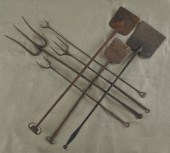 Group of forged iron fire tools
Group of forged iron fire tools 19th c. longest - 42" l. ?
Group of forged iron fire tools
Group of forged iron fire tools 19th c. longest - 42" l. ? -
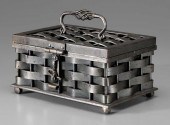 Wallins Forge Hand-Wrought Coffer
Wallins Forge Hand-Wrought Coffer Sparta, Kentucky, hand forged steel, intertwined strap construction, 8-1/2 in. including twist handle,
Wallins Forge Hand-Wrought Coffer
Wallins Forge Hand-Wrought Coffer Sparta, Kentucky, hand forged steel, intertwined strap construction, 8-1/2 in. including twist handle, -
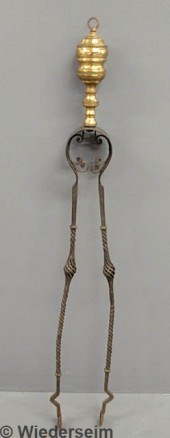 Wrought iron fireplace tongs with
Wrought iron fireplace tongs with brass handle. 40"h.
Wrought iron fireplace tongs with
Wrought iron fireplace tongs with brass handle. 40"h. -
 Pair folky blacksmith made Etruscan
Pair folky blacksmith made Etruscan motif andirons. 13'' Ht. 13'' D.
Pair folky blacksmith made Etruscan
Pair folky blacksmith made Etruscan motif andirons. 13'' Ht. 13'' D. -
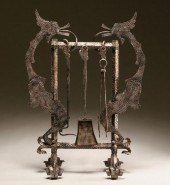 Gothic style silvered wrought
Gothic style silvered wrought iron fireplace set; the center section with tools flanked by mythical beasts. 29"H. Good condition with signs of wear.
Gothic style silvered wrought
Gothic style silvered wrought iron fireplace set; the center section with tools flanked by mythical beasts. 29"H. Good condition with signs of wear. -
 WROUGHT IRON TWO-PRONG FLESH FORK
WROUGHT IRON TWO-PRONG FLESH FORK INITIALED "M.A.Sca. 19th-20th century; crafted from salvaged file, the fork has fine arching handle with filework accent below flatwork grip, simple drilled eye hanger, engraved type lettering, 11 1/4", Condition: minimal rust
WROUGHT IRON TWO-PRONG FLESH FORK
WROUGHT IRON TWO-PRONG FLESH FORK INITIALED "M.A.Sca. 19th-20th century; crafted from salvaged file, the fork has fine arching handle with filework accent below flatwork grip, simple drilled eye hanger, engraved type lettering, 11 1/4", Condition: minimal rust -
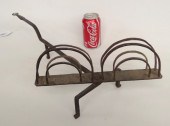 Blacksmith made iron toaster.
Blacksmith made iron toaster. 20'' Length.
Blacksmith made iron toaster.
Blacksmith made iron toaster. 20'' Length. -
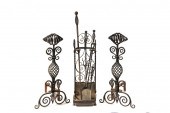 (7 PC) HAND WROUGHT IRON
(7 PC) HAND WROUGHT IRON FIREPLACE SET - Monumental Wrought Iron Arts & Crafts Fireplace Set possibly a Guild piece passing from Apprentice to Craftsman as it displays all the necessary components of twisted cage wrought and joined scroll twisted bar
(7 PC) HAND WROUGHT IRON
(7 PC) HAND WROUGHT IRON FIREPLACE SET - Monumental Wrought Iron Arts & Crafts Fireplace Set possibly a Guild piece passing from Apprentice to Craftsman as it displays all the necessary components of twisted cage wrought and joined scroll twisted bar -
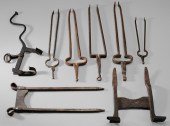 Hand-Wrought Fire Tongs, Kettle
Hand-Wrought Fire Tongs, Kettle Tilter, Boot Scrap
Hand-Wrought Fire Tongs, Kettle
Hand-Wrought Fire Tongs, Kettle Tilter, Boot Scrap -
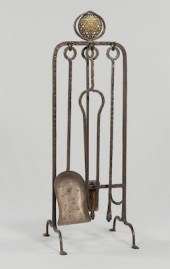 An Arts and Crafts Wrought Iron
An Arts and Crafts Wrought Iron Fireplace Set Wrought iron set with four tools; decorated on top with a pierced brass decoration. Measures approx. 35"H x 12"W.
An Arts and Crafts Wrought Iron
An Arts and Crafts Wrought Iron Fireplace Set Wrought iron set with four tools; decorated on top with a pierced brass decoration. Measures approx. 35"H x 12"W. -
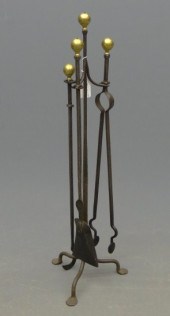 Brass and iron firetools. 42'' Ht.
Brass and iron firetools. 42'' Ht.
Brass and iron firetools. 42'' Ht.
Brass and iron firetools. 42'' Ht. -
 FOLK ART CRAFTED "DRAGON"
FOLK ART CRAFTED "DRAGON" BLACKSMITH MADE HAMMERca. late 20th century; altered blacksmith rivet hammer with reworked cross peen to receive comical form fire breathing dragon with pointed ears, deep conical eye sockets and flared nose holes, modern oak handle and round eye, 5 1/4"x 12 1/2"
FOLK ART CRAFTED "DRAGON"
FOLK ART CRAFTED "DRAGON" BLACKSMITH MADE HAMMERca. late 20th century; altered blacksmith rivet hammer with reworked cross peen to receive comical form fire breathing dragon with pointed ears, deep conical eye sockets and flared nose holes, modern oak handle and round eye, 5 1/4"x 12 1/2" -
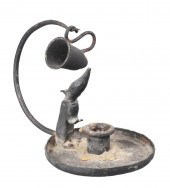 Forged iron mouse form chamberstick
Forged iron mouse form chamberstick and snuff, 5-3/4"H
Forged iron mouse form chamberstick
Forged iron mouse form chamberstick and snuff, 5-3/4"H -
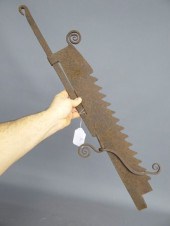 Blacksmith made iron trammel with
Blacksmith made iron trammel with incised hearts. 30'' Ht.
Blacksmith made iron trammel with
Blacksmith made iron trammel with incised hearts. 30'' Ht. -
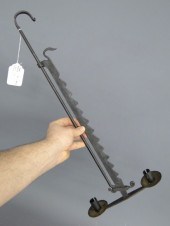 Blacksmith made iron trammel.
Blacksmith made iron trammel. 24'' Ht.
Blacksmith made iron trammel.
Blacksmith made iron trammel. 24'' Ht. -
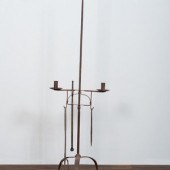 A Set of Wrought and Forged Iron
A Set of Wrought and Forged Iron Fireplace Tools on Stand American, 19th Century comprising a trident, a set of tongs, and a hooked article. stand with a two-light candleholder. Height of stand 51 1/8 inches.
A Set of Wrought and Forged Iron
A Set of Wrought and Forged Iron Fireplace Tools on Stand American, 19th Century comprising a trident, a set of tongs, and a hooked article. stand with a two-light candleholder. Height of stand 51 1/8 inches. -
 A Gilt Cast Metal Blacksmith
A Gilt Cast Metal Blacksmith Wired as a Lamp Blacksmith. Cast metal with worn gilt finish apprx. 11-1/2"H x 9" x 6" metal plate on the front reading "Le Forgeron" (The Blacksmith) foundry mark on the base "Fabrication Francais...Made In France...Paris" wired as a lamp toggle switch on the back of the base.
A Gilt Cast Metal Blacksmith
A Gilt Cast Metal Blacksmith Wired as a Lamp Blacksmith. Cast metal with worn gilt finish apprx. 11-1/2"H x 9" x 6" metal plate on the front reading "Le Forgeron" (The Blacksmith) foundry mark on the base "Fabrication Francais...Made In France...Paris" wired as a lamp toggle switch on the back of the base. -
 Three Hand-Wrought Iron Hing
Three Hand-Wrought Iron Hing
Three Hand-Wrought Iron Hing
Three Hand-Wrought Iron Hing -
 HAND-FORGED IRON MACEGerman
HAND-FORGED IRON MACEGerman hand-forged steel mace, c. 1580, the top section with a short finial above seven irregular shaped flanges, each with dolphins, the shaft and handle with grip grooves, overall: approx 23.25"l, 3.75lbs **Provenance: from a prominent Dallas, Texas estate. Purchased at Peter Finer Gallery, St. James, London**
HAND-FORGED IRON MACEGerman
HAND-FORGED IRON MACEGerman hand-forged steel mace, c. 1580, the top section with a short finial above seven irregular shaped flanges, each with dolphins, the shaft and handle with grip grooves, overall: approx 23.25"l, 3.75lbs **Provenance: from a prominent Dallas, Texas estate. Purchased at Peter Finer Gallery, St. James, London** -
 Five-Piece Miniature Blacksmith's
Five-Piece Miniature Blacksmith's Tool Set finely machined, swedge blocks, con
Five-Piece Miniature Blacksmith's
Five-Piece Miniature Blacksmith's Tool Set finely machined, swedge blocks, con -
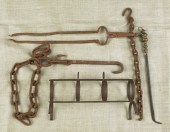 Wrought iron pipe kiln together
Wrought iron pipe kiln together with two fireplace tools chain trammel. ?
Wrought iron pipe kiln together
Wrought iron pipe kiln together with two fireplace tools chain trammel. ? -
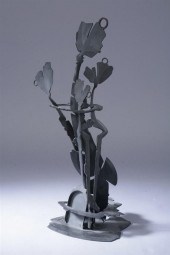 ALBERT PALEY CONTEMPORARY FORGED
ALBERT PALEY CONTEMPORARY FORGED AND FABRICATED STEEL FIRE TOOLS signed by the artist and dated 1996. With poker tongs shovel and stand - 40 in. x 16 in. x13 in.
ALBERT PALEY CONTEMPORARY FORGED
ALBERT PALEY CONTEMPORARY FORGED AND FABRICATED STEEL FIRE TOOLS signed by the artist and dated 1996. With poker tongs shovel and stand - 40 in. x 16 in. x13 in. -
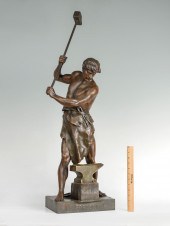 PICAULT SPELTER SCULPTURE LA FORGE:
PICAULT SPELTER SCULPTURE LA FORGE: Depicts a Blacksmith Swinging a Large Hammer Working at his Craft, 39'' in height, signed on the base.
PICAULT SPELTER SCULPTURE LA FORGE:
PICAULT SPELTER SCULPTURE LA FORGE: Depicts a Blacksmith Swinging a Large Hammer Working at his Craft, 39'' in height, signed on the base. -
 ANTIQUE FR LONDON "THE
ANTIQUE FR LONDON "THE FORGE-MOONRISE" PRINTAntique English print by F. R. London number 632 titled "The Forge-Moonrise" after J. W. Goyy? Mounted in a black painted wooden frame with mat behind glass screen. Paper measures approx. 10 3/8" height x 15 1/4"width (26.3cm x 38.7cm) to sight. Measures approx. 16 1/2" height x 21 1/4" width (41.9cm x 53.9cm) overall including frame. Condition: All lots are sold as is and where is. Elite Auctioneers, LLC provides condition reports upon request to aide in your bidding decision. No statement regarding age, condition, kind, value, or quality of a lot, whether made orally at the auction or at any other time, or in writing in this catalog or elsewhere, shall be construed to be an express or implied warranty, representation, or assumption of liability. All sales are final, Elite Auctioneers, LLC does not give refunds based on condition. Elite Auctioneers, LLC does not perform any shipping or packing services. We do have a list of suggested shippers who gladly provide quotes prior to your bidding. Please visit our webpage for a list of recommended shippers.All items listed as "attributed", "after", or "in the manner" are not being sold as original works and are not guaranteed authentic.
ANTIQUE FR LONDON "THE
ANTIQUE FR LONDON "THE FORGE-MOONRISE" PRINTAntique English print by F. R. London number 632 titled "The Forge-Moonrise" after J. W. Goyy? Mounted in a black painted wooden frame with mat behind glass screen. Paper measures approx. 10 3/8" height x 15 1/4"width (26.3cm x 38.7cm) to sight. Measures approx. 16 1/2" height x 21 1/4" width (41.9cm x 53.9cm) overall including frame. Condition: All lots are sold as is and where is. Elite Auctioneers, LLC provides condition reports upon request to aide in your bidding decision. No statement regarding age, condition, kind, value, or quality of a lot, whether made orally at the auction or at any other time, or in writing in this catalog or elsewhere, shall be construed to be an express or implied warranty, representation, or assumption of liability. All sales are final, Elite Auctioneers, LLC does not give refunds based on condition. Elite Auctioneers, LLC does not perform any shipping or packing services. We do have a list of suggested shippers who gladly provide quotes prior to your bidding. Please visit our webpage for a list of recommended shippers.All items listed as "attributed", "after", or "in the manner" are not being sold as original works and are not guaranteed authentic. -
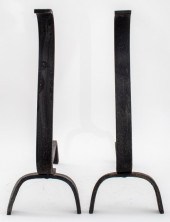 ARTS AND CRAFTS FORGED IRON
ARTS AND CRAFTS FORGED IRON ANDIRONS, PR Arts and Crafts period forged iron fireplace andirons, first quarter 20th century or later, with arching necks and u-form supports, reminiscent of the style of Donald Deskey. 19" H x 7" W x 22" D
ARTS AND CRAFTS FORGED IRON
ARTS AND CRAFTS FORGED IRON ANDIRONS, PR Arts and Crafts period forged iron fireplace andirons, first quarter 20th century or later, with arching necks and u-form supports, reminiscent of the style of Donald Deskey. 19" H x 7" W x 22" D -
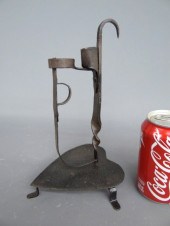 Blacksmith made iron alpine lamp. 9
Blacksmith made iron alpine lamp. 9 1/2'' Ht.
Blacksmith made iron alpine lamp. 9
Blacksmith made iron alpine lamp. 9 1/2'' Ht. -
 Group of hand forged butcher's
Group of hand forged butcher's tools 19th c. together with three tongs. ?
Group of hand forged butcher's
Group of hand forged butcher's tools 19th c. together with three tongs. ? -
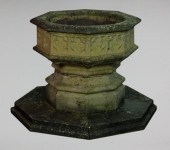 A Haddonstone octagonal font
A Haddonstone octagonal font moulded with quatrefoils on page 4
A Haddonstone octagonal font
A Haddonstone octagonal font moulded with quatrefoils on page 4
...many more examples with full details are available to our members - Learn more


